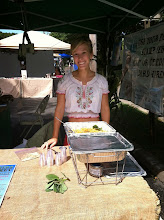Wild Watercress: A Superfood Foraged in the Forests of Long Island
The mild weather of this week offered a great opportunity to catch up on some hiking and recharge outdoors. Thankfully to Professional Chef, Foragers and Entrepreneurs Kyle Fiasconaro and Doug Weiler of Lost and Found Popup Restaurant, my outdoor recovery also included foraging. "What the heck is alive in the local forests that we can eat during the dead of winter," you ask! Only one of the world's greatest unknown superfoods- watercress (Nasturtium officinale)!

Watercress is a dark leafy green of
the mustard family that grows wildly in cool fresh waster streams. Much like its
relatives, it has a pungent, mustardy and peppery flavor. Not only does it
boast more than 15 essential vitamins and minerals, more iron that spinach,
more vitamin C than oranges, more folic acid than bananas, and more calcium
than milk, but it also helps significantly reduce DNA damage to blood cells and
helps cells resist further DNA damage to white blood cells caused by free
radicals by 22.9%. Watercress has one of the highest levels of glucosinolates
and carotenoids per gram of any vegetable. These phytochemicals have been
associated with a range of cancer-fighting properties and antioxidant
activities.
The healing power of watercress is
no new discovery. Hippocrates, known as the father of medicine who believed in
the healing powers of food, first recognized its healing capacity in the days
of antiquity. His first hospital is said to have been located along a fresh
water stream (where watercress grows) to ensure easy access for his treatments.
Greek soldiers drank a tonic containing watercress before going into battle and Romans even fed it to their emperors and used it as a cure for baldness. However,
despite evidence of ancient use, our peppery friend suffered a decline in
popularity during the last half century, due to the influx in accessibility of more
“exotic” foreign greens. Fortunately its superfood benefits are being
rediscovered and it is become easier to find.

As one of the
strongest tasting salad leaves, you may think, “what the heck do I do with it?”
However, don’t be intimidated by its flavor! You can use watercress in salads,
potato soups, omelets, sandwiches, or as a garnish for cooked foods such as
game. Both the leaves and stems are edible, but watercress is highly perishable
and will only last up to 3 days, sealed in your fridge. Give it a try!
Best of all, since it can be foraged in local forests you don't have to worry about if it's organic or not. Though it may take some time for you to find your own patch of wild watercress, start looking in places that have fresh water streams. Avoid areas that are located near large roadways or sheer, cattle or pig pastures, as the stream water may host the Liver Fluke parasite. Be sure to wash your watercress throughly. You can even give it a bath in 6% vinegar to ensure any pesty parasites are exterminated. As with any other foraged food, don't eat anything before checking with a professional or field guild reference! I recommend "The Forager's Harvest" by Samuel Thayer or John Kallas' "Edible Wild Plants." I was lucky enough to be introduced to my watercress spot by Kyle and Doug. Thanks again guys for introducing me to the eccentric world of foraging!




No comments:
Post a Comment